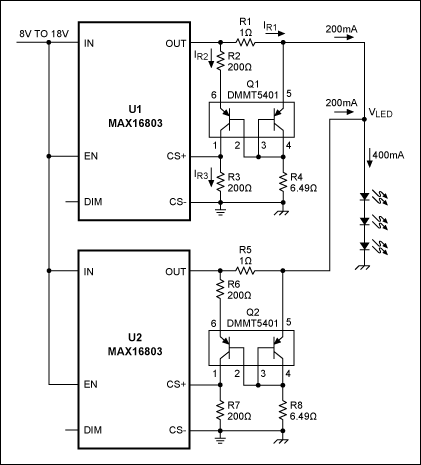Level Shifter Helps to Parallel LED Current Drivers
要約
Using a pair of matched transistors to translate a high-side current-sense signal down to a ground reference, this circuit lets you parallel LED-driver circuits as required to achieve the desired drive current.
A similar version of this article appeared in the February 19, 2008 issue of Machine Design magazine.
As white LEDs become more pervasive, the industry provides more options for driving them. Linear constant-current drivers, for instance, offer low EMI, low cost, and require only a few components. Many designers favor them for the lower-current applications in which power loss is a minor concern. If power dissipation is a problem, or if the application requires more current, you can parallel two or more drivers. Two drivers in parallel provides twice as much current and splits the power loss into two locations, which makes it easier to dissipate.
High-side pass elements are preferred, especially in automotive applications, because they allow you to connect only a single current-limited wire (chassis return) to the load. To configure parallel drivers with high-side pass elements, however, the current-sense feedback circuitry must also be on the high side, and it must be able to withstand at least the voltage created by the LED load. Thus, linear drivers pose a dilemma if they have either low-side current-sense feedback or a requirement for limited common-mode voltage on the sense inputs.
Suppose we want to drive an LED string with 400mA (Figure 1). Drivers U1 and U2 (MAX16803) are good for automotive use because they have a high input-voltage range, excellent thermal characteristics, and the automotive temperature range. Their maximum output current, however, is 350mA. Also, with maximum input voltages of 16V, each IC would dissipate 3.6W—far too much for one package to handle. One solution is to use two drivers, with each handling half of the current and heat. For the drivers to share current equally, their current-sense resistors must be on the high (anode) side of the LEDs. That arrangement introduces another problem: forward voltage for the three LEDs in series reaches almost 8V, but the maximum rating for the current-sense (CS) pins is only 6V.

Figure 1. Matched transistors provide a current-sense level shifter for these LED drivers.
A matched transistor pair (Q1) solves this problem by translating the current-sense voltage (developed across R1) onto R3. Because the bases are connected together, voltages at the emitters are nearly the same, and therefore R2 × IR2 equals R1 × IR1. High gain in the transistors means negligible base current, so IR3 is approximately equal to IR2. You can set the output current as follows:

where VSENSE is the current-sense voltage between CS+ and CS- (203mV). For best accuracy, choose R4 so the two transistor currents are about the same:

where VLED is the nominal LED voltage at the desired load. This additional low-cost circuitry keeps the CS-pin voltages near ground, and allows the sense resistor (R1) to be at any voltage up to the 45V limit of U1.
The second driver must have an identical circuit. Tie the driver outputs together to obtain the full LED current. If more current or power-handling capability is needed, you can add more drivers in parallel.